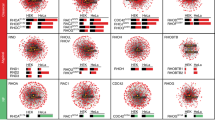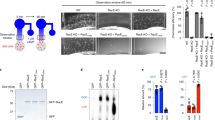Abstract
The members of the Dock180 superfamily of proteins are novel guanine nucleotide exchange factors (GEF) for Rho family GTPases and are linked to multiple biological processes from worms to mammals. ELMO is a critical regulator of Dock180, and the Dock180–ELMO complex functions as a bipartite GEF for Rac. We identified a mechanism wherein the PH domain of ELMO, by binding the Dock180–Rac complex in trans, stabilizes Rac in the nucleotide-free transition state. Mutagenesis studies reveal that this ELMO PH domain–dependent regulation is essential for the Dock180–ELMO complex to function in phagocytosis and cell migration. Genetic rescue studies in Caenorhabditis elegans using ELMO and its homolog CED-12 support the above observations in vivo. These data reveal a new mode of action of PH domains and a novel, evolutionarily conserved mechanism by which a bipartite GEF can activate Rac.
This is a preview of subscription content, access via your institution
Access options
Subscribe to this journal
Receive 12 print issues and online access
$189.00 per year
only $15.75 per issue
Buy this article
- Purchase on Springer Link
- Instant access to full article PDF
Prices may be subject to local taxes which are calculated during checkout





Similar content being viewed by others
References
Cote, J.F. & Vuori, K. Identification of an evolutionarily conserved superfamily of DOCK180-related proteins with guanine nucleotide exchange activity. J. Cell Sci. 115, 4901–4913 (2002).
Brugnera, E. et al. Unconventional Rac-GEF activity is mediated through the Dock180–ELMO complex. Nat. Cell Biol. 4, 574–582 (2002).
Meller, N., Irani-Tehrani, M., Kiosses, W.B., Del Pozo, M.A. & Schwartz, M.A. Zizimin1, a novel Cdc42 activator, reveals a new GEF domain for Rho proteins. Nat. Cell Biol. 4, 639–647 (2002).
Yajnik, V. et al. DOCK4, a GTPase activator, is disrupted during tumorigenesis. Cell 112, 637–684 (2003).
Fukui, Y. et al. Haematopoietic cell-specific CDM family protein DOCK2 is essential for lymphocyte migration. Nature 412, 826–831 (2001).
Albert, M., Kim, J. & Birge, R. avb5 integrin recruits the CrkII–Dock180–Rac1 complex for phagocytosis of apoptotic cells. Nat. Cell Biol. 2, 899–905 (2000).
Gumienny, T.L. et al. CED-12/ELMO, a novel member of the crkII/Dock180/Rac pathway, is required for phagocytosis and cell migration. Cell 107, 27–41 (2001).
Grimsley, C.M. et al. Dock180 and ELMO1 proteins cooperate to promote evolutionarily conserved Rac-dependent cell migration. J Biol. Chem. 279, 6087–6097 (2004).
Kiyokawa, E. et al. Activation of Rac1 by a Crk SH3-binding protein, DOCK180. Genes Dev. 12, 3331–3336 (1998).
Duchek, P., Somogyi, K., Jekely, G., Beccari, S. & Rorth, P. Guidance of cell migration by the Drosophila pdgf/vegf receptor. Cell 107, 17–26 (2001).
Erickson, M.R., Galletta, B.J. & Abmayr, S.M. Drosophila myoblast city encodes a conserved protein that is essential for myoblast fusion, dorsal closure, and cytoskeletal organization. J. Cell Biol. 138, 589–603 (1997).
Nolan, K.M. et al. Myoblast city, the Drosophila homolog of DOCK180/CED-5, is required in a Rac signaling pathway utilized for multiple developmental processes. Genes Dev. 12, 3337–3342 (1998).
Reddien, P.W. & Horvitz, H.R. CED-12/CrkII and CED-10/Rac control phagocytosis and cell migration in Caenorhabditis elegans. Nat. Cell Biol. 2, 131–136 (2000).
Wu, Y.C. & Horvitz, H.R. C. elegans phagocytosis and cell-migration protein CED-5 is similar to human DOCK180. Nature 392, 501–504 (1998).
Lundquist, E.A., Reddien, P.W., Hartwieg, E., Horvirz, H.R. & Bargmann, C.I. Three C. elegans Rac proteins and several alternative Rac regulators control axon guidance, cell migration and apoptotic cell phagocytosis. Development 128, 4475–4488 (2001).
Wu, Y.C., Tsai, M.C., Cheng, L.C., Chou, C.J. & Weng, N.Y. C. elegans CED-12 acts in the conserved crkII/DOCK180/Rac pathway to control cell migration and cell corpse engulfment. Dev. Cell 1, 491–502 (2001).
Zhou, Z., Caron, E., Hartwieg, E., Hall, A. & Horvitz, H.R. The C. elegans PH domain protein CED-12 regulates cytoskeletal reorganization via a Rho/Rac GTPase signalling pathway. Dev. Cell 1, 477–489 (2001).
Schmidt, A. & Hall, A. Guanine nucleotide exchange factors for the Rho GTPases: Turning on the switch. Genes Dev. 16, 1587–1609 (2002).
Hoffman, G.R. & Cerione, R.A. Signaling to the Rho GTPases: networking with the DH domain. FEBS Lett. 513, 85–91 (2002).
Snyder, J.T. et al. Quantitative analysis of the effect of phosphoinositide interactions on the function of Dbl family proteins. J. Biol. Chem. 27, 27 (2001).
Worthylake, D.K., Rossman, K.L. & Sondek, J. Crystal structure of Rac1 in complex with the guanine nucleotide exchange region of Tiam1. Nature 408, 682–688 (2000).
Rossman, K.L. et al. A crystallographic view of interactions between Dbs and Cdc42: PH domain-assisted guanine nucleotide exchange. EMBO J. 21, 1315–1326 (2002).
Katoh, H. & Negishi, M. RhoG activates Rac1 by direct interaction with the Dock180-binding protein Elmo. Nature 424, 461–464 (2003).
Sanui, T. et al. DOCK2 regulates Rac activation and cytoskeletal reorganization through interaction with ELMO1. Blood 102, 2948–2950 (2003).
Nishihara, H. et al. Non-adherent cell-specific expression of DOCK2, a member of human CDM-family proteins. Biochim. Biophys. Acta 1452, 179–187 (1999).
Chen, Q., Kimura, H. & Schubert, D. A novel mechanism for the regulation of amyloid precursor protein metabolism. J. Cell Biol. 158, 79–89 (2002).
Namekata, K., Enokido, Y., Iwasawa, K. & Kimura, H. MOCA induces membrane spreading by activating Rac1. J. Biol. Chem. 279, 14331–14337 (2004).
Vetter, I.R., Arndt, A., Kutay, U., Gorlich, D. & Wittinghofer A structural view of the Ran-importin β interaction at 2.3 Å resolution. Cell 97, 635–646 (1999).
Snyder, J.T., Singer, A.U., Wing, M.R., Harden, T.K. & Sondek, J. The pleckstrin homology domain of phospholipase C-β2 as an effector site for Rac. J. Biol. Chem. 278, 21099–21104 (2003).
Brenner, S. The genetics of Caenorhabditis elegans. Genetics 77, 71–94 (1974).
Mello, C.C., Kramer, J.M., Stinchcomb, D.T. & Ambros, V. Efficient gene transfer in C. elegans: extrachromosomal maintenance and integration of transforming sequences. EMBO J. 10, 3959–3970 (1991).
Rojas, R.J., Kimple, R.J., Rossman, K.L., Siderovski, D.P. & Sondek, J. Establishment and emerging fluorescence-based assays for G-protein function: Ras-superfamily GTPases. Comb. Chem. High Throughput Screen. 6, 409–418 (2003).
Acknowledgements
We thank A. Bouton and J. Casanova for comments on the manuscript and V. Yajnik, as well as members of the Ravichandran laboratory, for helpful discussions. We also thank M. Matsuda for original Dock180 plasmids and I. Macara for the His-tagged bacterially produced Rac. This work was supported by a US National Institutes of Health (NIH) grant GM-64709 (to K.S.R.) and grants from the Swiss National Science Foundation, The Ernst Hadorn Foundation, and the European Union (FP5 project APOCLEAR) to M.O.H. C.G. was supported by an Infectious Diseases Training grant from the NIH.
Author information
Authors and Affiliations
Corresponding author
Ethics declarations
Competing interests
The authors declare no competing financial interests.
Supplementary information
Supplementary Fig. 1
Dock WA/GE and Dock DSH3/GE mutants do not bind ELMO. (PDF 488 kb)
Supplementary Fig. 2
W665A mutant of full-length ELMO is less active than wild-type ELMO in GEF assay. (PDF 64 kb)
Rights and permissions
About this article
Cite this article
Lu, M., Kinchen, J., Rossman, K. et al. PH domain of ELMO functions in trans to regulate Rac activation via Dock180. Nat Struct Mol Biol 11, 756–762 (2004). https://doi.org/10.1038/nsmb800
Received:
Accepted:
Published:
Issue Date:
DOI: https://doi.org/10.1038/nsmb800
This article is cited by
-
circRNA432 enhances the coelomocyte phagocytosis via regulating the miR-2008-ELMO1 axis in Vibrio splendidus-challenged Apostichopus japonicus
Communications Biology (2023)
-
Biasing the conformation of ELMO2 reveals that myoblast fusion can be exploited to improve muscle regeneration
Nature Communications (2022)
-
Role of ELMO1 in inflammation and cancer—clinical implications
Cellular Oncology (2022)
-
ELMO1 signaling is a promoter of osteoclast function and bone loss
Nature Communications (2021)
-
Elmo1 function, linked to Rac1 activity, regulates peripheral neuronal numbers and myelination in zebrafish
Cellular and Molecular Life Sciences (2020)



